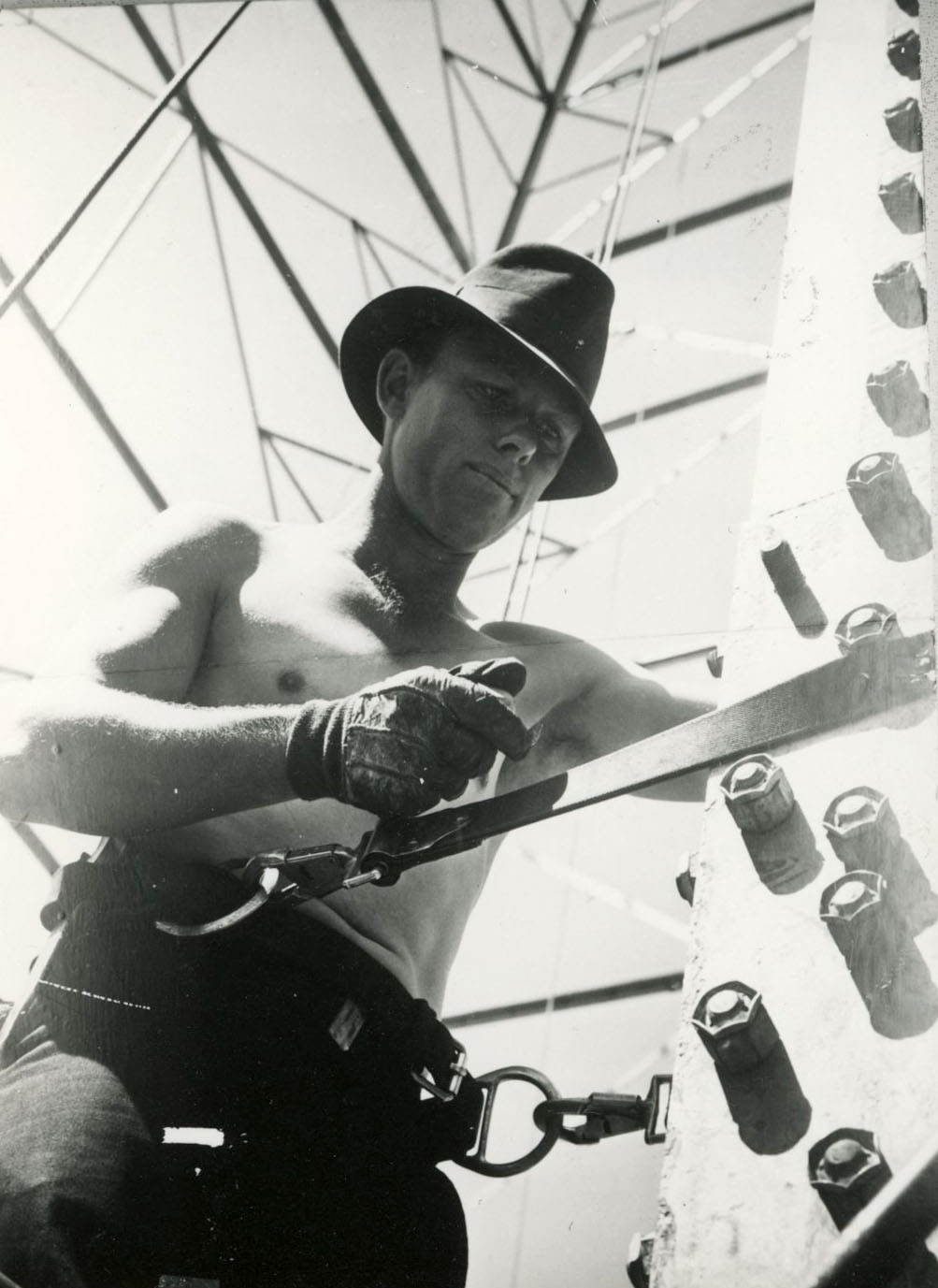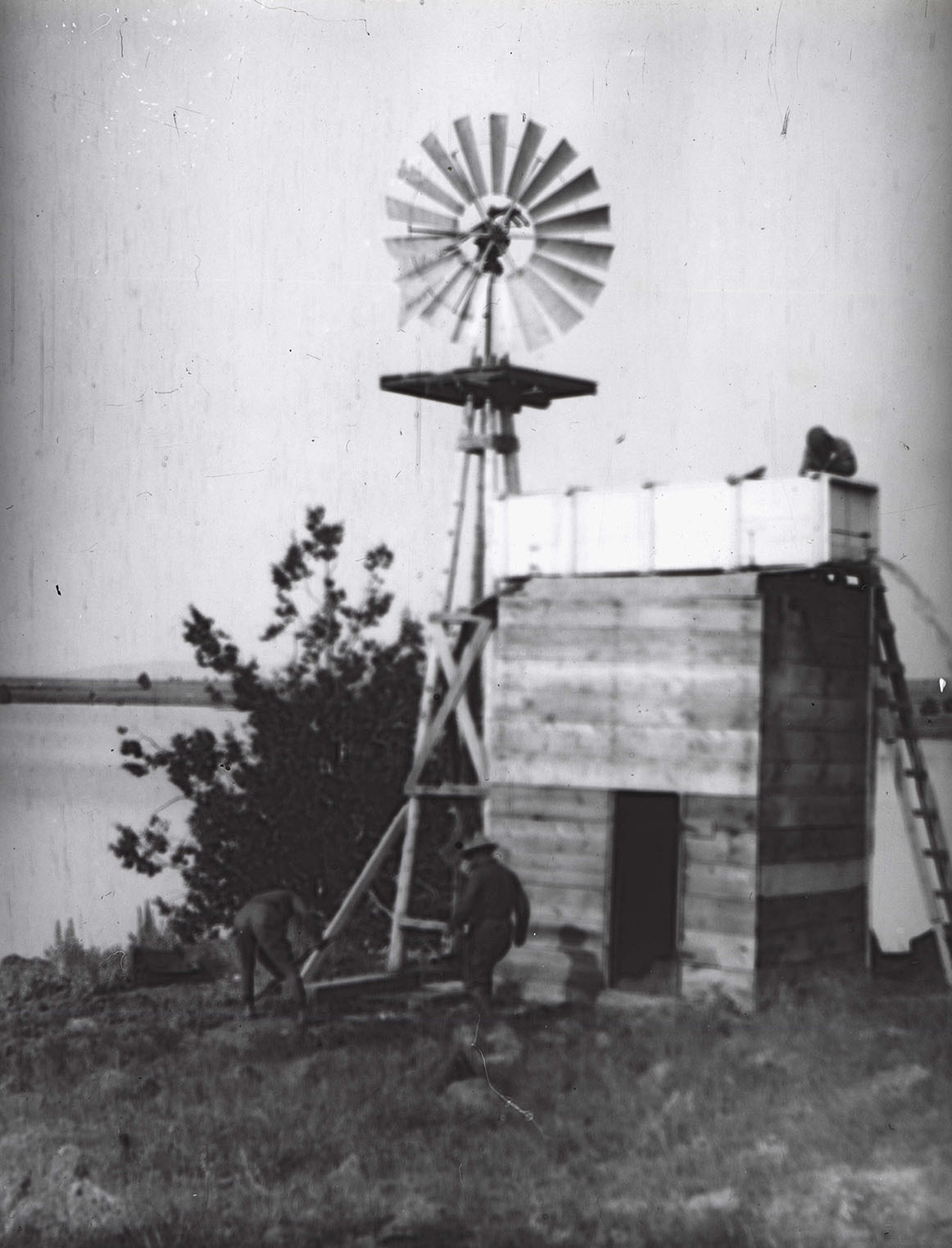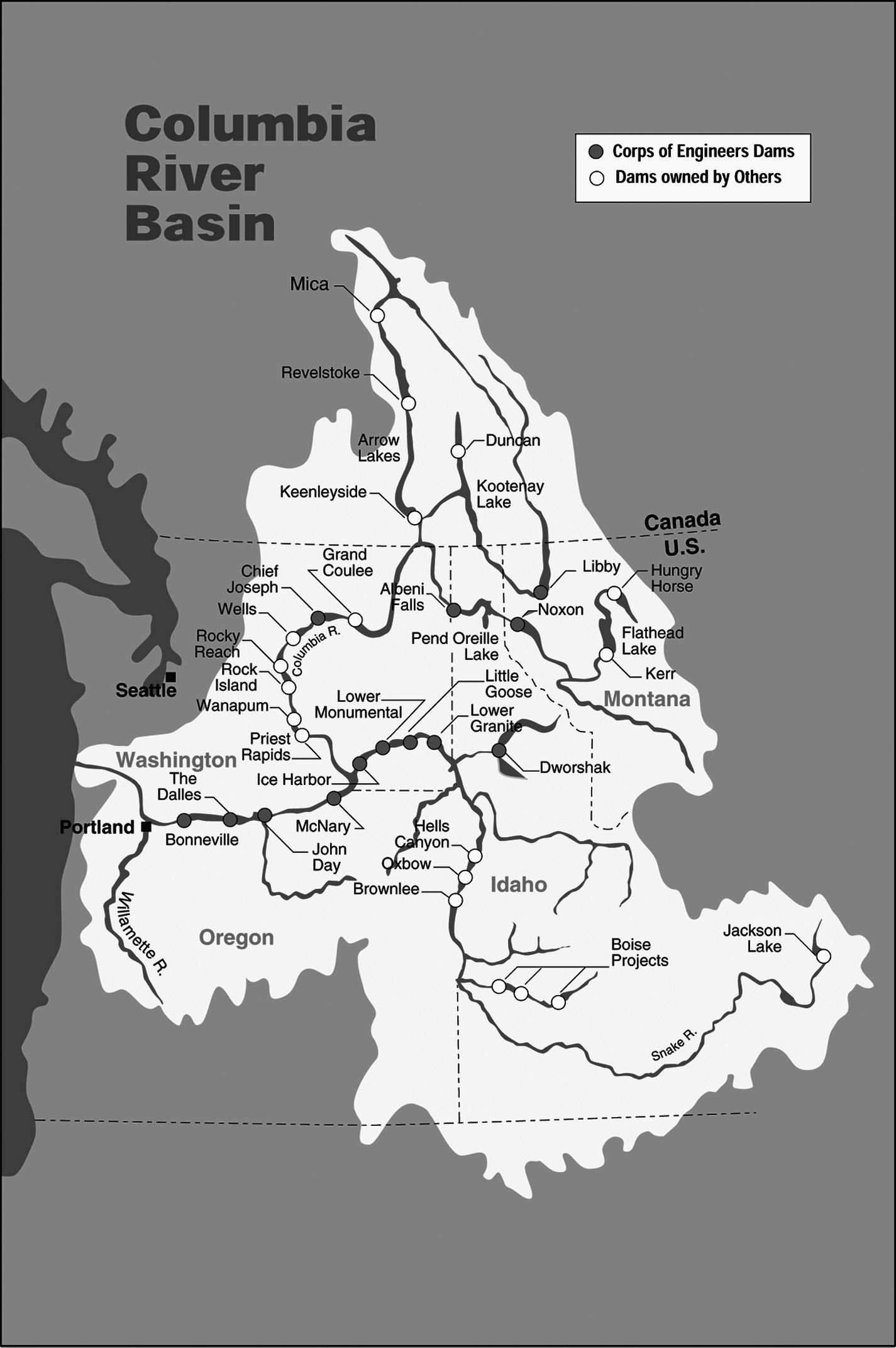No area of the West is isolated from the western electric power supply, which is interconnected by one big high-voltage transmission system from British Columbia to northern Mexico and from the Continental Divide to the Pacific Ocean. When Oregon and other Northwest states need power for a heating load in the winter, the warmer Southwest can send it. When the Southwest needs power for an air conditioning load in the summer, the cooler Northwest can send it.
These transmission lines lace across the West like the strands of a spider’s web. The largest sets of lines run from the Columbia River to the Los Angeles area and collectively are known as the Pacific Northwest–Pacific Southwest Intertie. The history of those lines involves a 1940s drought in California not unlike twenty-first-century climate conditions, interregional infighting among public and investor-owned electric utilities and state and federal governments, and an international treaty with Canada.
Climate, Drought, and Hydroelectricity
Twenty-two years into the twenty-first century, the West is in the midst of a drought so severe that there hadn’t been one like it in twelve hundred years. As the drought continues, so does concern for one of the major sources of electricity in the West—hydropower. Reservoirs on the Colorado River are so low, as the result of the extended drought, that hydropower generation could be reduced or even halted—a climate-induced crisis that would affect millions of electricity consumers. A study published in Climate Dynamics in May 2021 and written by eleven climate scientists, including seven from the National Center for Atmospheric Research in Boulder, Colorado, predicted that by the year 2100 snowpack in the mountains of the Northwest will be reduced by at least 70 percent and may be gone altogether. This will have an impact on hydropower generation, as snow is the stored “fuel” for hydropower.
At the same time, this and other climate studies predict that precipitation in the Pacific Northwest will change seasonally—not less precipitation but more rain in winter and drier conditions in summer; but not in every year, according to data compiled by the River Management Joint Operating Committee, which predicts future river flows for the purpose of predicting hydropower operations. As the snowpack becomes smaller and runoff occurs earlier than in 2022, river flows will change, which will affect hydropower generation, but not by much according to RMJOC.
It would be difficult to alter hydropower operations to offset the increased likelihood of lower summer flows, because of nonpower legal constraints like spilling water over dams to aid fish passage. Those constraints will limit how much water can be stored in the autumn and held through the winter until the following summer, because of the low storage capability of the river system compared to total flow volume (about 25 million acre-feet of storage compared to average annual flow of 160 million acre-feet). More storage would help, but it will be impossible to find viable locations for more large reservoirs in the Columbia River Basin.
In the Northwest, then, climate change might not make much difference in hydropower generation, but drought could reduce it elsewhere in the West and Southwest. That possibility underscores an important continuing role for the Intertie: allowing for interregional power transfers from areas that have surplus generation to areas that do not.
As climate change increasingly has an impact, sources of electricity will change. In the early twenty-first century, aging and inefficient thermal power plants fueled by coal and natural gas—particularly coal—are being retired, and thousands of megawatts of new renewable energy generators are being built, particularly solar power in California. The increasing presence of inexpensive solar power is forcing other, more expensive types of generation out of the competitive wholesale electricity market, particularly at midday. The Northwest is taking advantage of the increasing amount of solar power through the Intertie.
Intertie History
The Intertie comprises three sets of lines: two 500-kilovolt alternating current lines approximately 940 miles long, from the John Day Dam on the Columbia River to the Lugo Substation near Los Angeles; a direct current (DC) from the Celilo Converter Station near The Dalles Dam to the Sylmar Converter Station in northern Los Angeles; and a 500-kilovolt alternating current (AC) line from the Alvey Substation near Eugene to the Tesla Substation near San Francisco. In all, the Intertie connects electrical systems in eleven states and the Province of British Columbia. The reason for both AC and DC lines is that utilities can take alternating current anywhere along the line, while DC is a straight shot, in this case from Celilo to Sylmar. Direct current is the most efficient way to transmit large amounts of electricity long distances, because the loss of voltage is minimal and construction costs are lower than alternating current transmission.
The first published proposal for a series of high-voltage transmission lines connecting the Northwest and the Southwest appeared in a 1919 paper by engineering professor Carl Magnusson at the University of Washington. Several years later, in the 1930s, President Franklin D. Roosevelt touted the idea as part of his rationale for creating a federal agency, the Bonneville Power Administration, to sell electricity generated at Bonneville and Grand Coulee Dams. But it was the drought of 1948 that finally jump-started the idea, and it was the impact of drought on hydropower production that became a key argument in favor of building the lines.
The drought-induced hydropower impacts were not in the hydropower-rich Northwest, however, but in California. At the Northwest Public Power Association meeting in Port Angeles, Washington, in August 1948, Ben Creim, power manager of the Bureau of Reclamation in Sacramento, said that an intertie could have prevented energy shortages in California by importing electricity from the Northwest. It could also have prevented an anticipated shortage of power to meet peak loads in the Northwest by exporting power from California. That shortage occurred the following December. Creim advocated an intertie connecting Bonneville Power Administration lines in the north to Central Valley Project lines in California.
The proposal was modest compared to another made at about the same time. The previous March, Assistant Secretary of the Interior William Warne had written to Congressman Norris Poulson of California proposing to divert Columbia River water to his state for power production. This caused panic in the Northwest, and candidates for public office voiced their anger over the proposal, which some described as power theft. The diversion never occurred.
The controversy stalled the Intertie proposal until 1951, however, when two agencies of the U.S. Defense Department declared that a connection between the Northwest and Southwest would be in the interest of national defense. This prompted the Secretary of the Interior to direct the Bonneville Power Administration and the U.S. Bureau of Reclamation to proceed with construction. But the year before, the U.S. House Appropriations Committee had determined that the line was not authorized, still preferring that the line not be built until a thorough study of the proposal was completed. Construction was paused until the late 1950s. By then, under the Eisenhower administration, the impetus for building an intertie had changed. The proposal was no longer focused on relieving the effects of drought on hydropower production in California, which federal agencies preferred. Now the proposal focused on benefiting the customers of privately owned power companies, particularly San Francisco-based Pacific Gas & Electric. The intertie would now meld inexpensive Northwest hydropower with more expensive generation in California.
PG&E, then and still one of the largest electric utilities in the country, wanted access to Columbia River hydropower. By March 1959, it had signed power-sales contracts with the Bonneville Power Administration and was ready to build a portion of an intertie through northern California. But California Governor Edmund Brown and Washington Governor Albert Rosellini opposed the Intertie, reflecting public opposition up and down the West Coast to sending power generated in one region to serve customers in another.
Oregon Governor Mark O. Hatfield joined Brown and Rosellini in testifying at a U.S. Senate Interior and Insular Affairs Committee hearing in April 1959. Hatfield asked that a feasibility study be completed before proceeding with construction, and Rosellini and Brown supported him. Rosellini asked for legislation to ensure that, if the lines were built, each region had preference to the electricity generated within its boundaries. This was particularly important in the Northwest, where customers of the public utilities that bought their power from Bonneville were paying the debt service on the construction of the Columbia River hydropower system through their electricity rates.
The study the governors had asked for, submitted to the committee in February 1960, confirmed the feasibility of an intertie. At hearings in May, the three governors asked for more study and the time to draft legislation that would ensure preference. The whole matter was put off until after the 1960 elections. The new study completed for the three governors proposed a larger intertie and a direct-current line to Los Angeles to help with its power needs. That helped win support from California’s congressional delegation. The Kennedy administration took note, and the president advised Congress in February 1961 that he had directed the Secretary of the Interior to develop plans for an intertie that would facilitate “the cooperative pooling of electric power, both public and private.”
Legislation ensuring regional preference for power from the Intertie languished until 1963, when the Senate adopted a bill that guaranteed electricity customers in the Northwest preference to power generated at federal hydroelectric dams in the region. Construction of the Intertie was authorized if the Senate bill became law, which it did in 1964. Also that year, sixteen entities in the Northwest, including federal water and power agencies and electric utilities, signed the Pacific Northwest Coordination Agreement. The PNCA committed participants to coordinate the operations of the hydropower plants to maximize their efficiency, including the coordination of Columbia River Basin dams in the United States and British Columbia.
That commitment was important to the implementation of the Columbia River Treaty, a key electric power development ratified in 1964. The Treaty authorized the construction of three dams in Canada (Keenleyside, Duncan, and Mica) and one in the United States (Libby), from which water releases would be controlled to maximize hydropower generation downstream in the United States. In return, the Treaty guaranteed Canada half of the additional generation. Called the Canadian Entitlement, it played an important role in approval of the Intertie. Northwest utilities wanted to sell only surplus power on the Intertie, and surplus power is a seasonal commodity in the Northwest, mostly available during the spring and early summer when the mountain snow melts and Columbia River Basin dams often generate more power than the region needs. But utilities in California and the Southwest wanted firm power—power that is delivered year-round—and British Columbia wanted to sell it to them from their Treaty entitlement.
“California would consent to the Intertie only if they could get firm power. We didn’t need the Canadian power in the Northwest,” former BPA Charles Luce told Gene Tollefson, who wrote a history of Bonneville, BPA and the Struggle for Power at Cost. “There was no political opposition to selling Canadian firm power in California. So all of a sudden, what seemed to us to be a problem and a liability, namely how to market this Canadian power, became an asset and an opportunity.” The Intertie made the British Columbia–California transactions possible, and it was finally on the road to construction.
The West Coast Electron Superhighway
In 2022, the direct-current Intertie lines could carry up to 3,100 megawatts of electricity, and the alternating current lines could carry up to 4,800 megawatts, creating a combined capacity of 7,900 megawatts. The Intertie lines operate reliably and only rarely shut down, as during an emergency such as a wildfire. Particulates in the smoke from fires can cause electricity to short to the ground; and when a major fire creates heavy smoke, portions of the lines are shut down temporarily and the power is rerouted to other lines. This happened in the summer of 2021 when the Bootleg fire raged along the Oregon-California state line, eventually burning through more than 413,000 acres.
The Intertie has a unique history that includes the effects of drought on California hydropower, not unlike concern for the effects of the twenty-first-century drought on hydropower production; the protection of the Columbia River from diversion to California; the preference for Columbia River hydropower assured to Northwest customers; and the sale of Canadian Entitlement power to the Pacific Southwest. “The history of the West Coast Interties,” historian Gus Norwood wrote in Columbia River Power for the People (1981), “is dramatic and instructive; it involved many technological, political, and economic obstacles.”
It is a rare project of this size that gives everyone what they want, but the Intertie is a good example. The United States and Canada agreed on how to share the benefits of Columbia River hydropower production; electricity consumers in California and the Southwestern states got access to inexpensive Columbia River power through the Canadian Entitlement; and electricity consumers in the Northwest benefit from access to the seemingly unending growth of inexpensive solar power in California, which can be seen as a hedge against the probable drought-induced decline of hydropower production in the state. And, if drought continues throughout the West and as climate change reduces snowpack, the Intertie will be the pathway to the Southwest for hydropower from the Northwest. “This system is proof of the power of cooperation and unity,” President Lyndon Johnson said in a prescient speech in Portland in 1964. “You have proved that if we turn away from division, if we just ignore dissention and distrust, there is no limit to our achievements.”
-
![]()
"Fitness Program," editorial cartoon, Oregon Journal, 1964.
Oregon Historical Society Research Library, Mss 5537
-
![]()
Pacific Northwest-Pacific Southwest Intertie map.
Courtesy U.S. Bureau of Reclamation -
![]()
Celilo Converter Station, 1968.
Oregon Historical Society Research Library, Orhi 81761
-
![]()
Men building transmission tower for PGE, 1949.
Oregon Historical Society Research Library, OrgLot151_PGE49-58 -
![]()
The mouth of the John Day River, flowing into the Columbia, 1964; John Day Dam in the background.
Courtesy Oregon Hist. Soc. Research Lib., Oregonian, 57783, photo file 905j
-
![]()
Pacific Northwest–Pacific Southwest Intertie map.
Courtesy Bonneville Power, Northwest Power and Conservation Council
Related Entries
-
![Bonneville Dam]()
Bonneville Dam
The U.S. Army Corps of Engineers built and operated Bonneville Lock and…
-
![Bonneville Power Administration]()
Bonneville Power Administration
In 1937, the impending completion of Bonneville Dam (1938) and progress…
-
![Climate Change and the History of Energy in Oregon]()
Climate Change and the History of Energy in Oregon
Unlike in other parts of the country, hydropower is the largest source …
-
![Climate Change in Oregon]()
Climate Change in Oregon
Within a few hundred miles in Oregon, you can see snowy volcanoes, parc…
-
![Columbia River]()
Columbia River
The River For more than ten millennia, the Columbia River has been the…
-
![Columbia River Treaty (1964)]()
Columbia River Treaty (1964)
The high-voltage power lines that march across central Oregon, linking …
-
![Energy Trust of Oregon]()
Energy Trust of Oregon
Energy Trust of Oregon was established in 2002 as a nonprofit organizat…
-
![Northwest Power Act (1980)]()
Northwest Power Act (1980)
In 1980, after four years of deliberation and several attempts, Congres…
-
![The Dalles Dam]()
The Dalles Dam
The United States Army Corps of Engineers constructed The Dalles Dam be…
-
![U.S. Bureau of Reclamation]()
U.S. Bureau of Reclamation
The U.S. Bureau of Reclamation, in the Department of the Interior, has …
Related Historical Records
Map This on the Oregon History WayFinder
The Oregon History Wayfinder is an interactive map that identifies significant places, people, and events in Oregon history.
Further Reading
Norwood, Gus. Columbia River Power for the People: A History of the Bonneville Power Administration. United States Department of Energy, Bonneville Power Administration, Portland, 1981.
Intertie. Northwest Power and Conservation Council. Columbia River History Project.
Tollefson, Gene. BPA and the struggle for power at cost. Portland, Ore.: Bonneville Power Administration, 1987.
"Climate Change & FCRPS." Bonneville Power Administration, 2022.
















